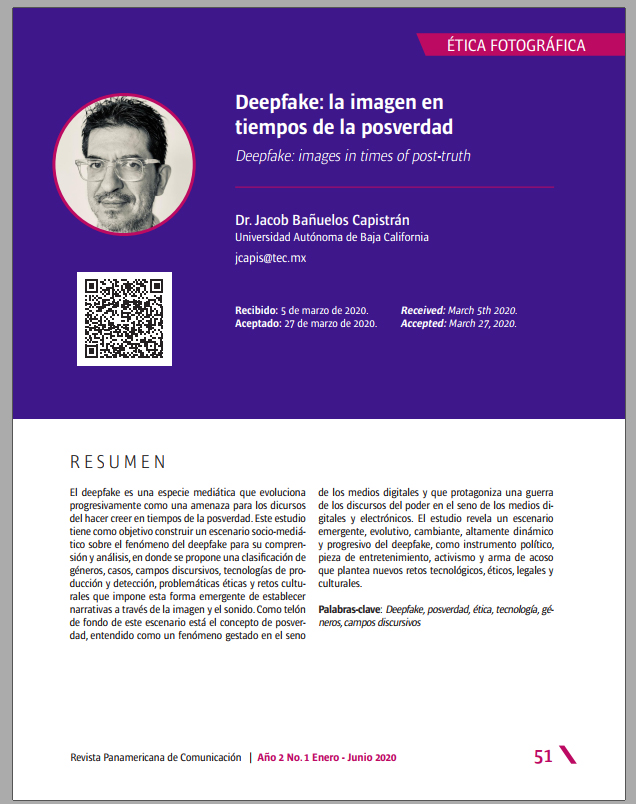Deepfake: images in times of post-truth.
Main Article Content
Abstract
This study aims at constructing a socio-mediatic scenario that will enable an analysis of the deepfake phenomenon, a true threat to discourses in time of post-truth. To do so, it proposes a classification of genres, cases, discursive fields, technologies of production and detection, ethical issues and cultural challenges that are imposed by this emergent form of constructing narratives through image and sound. The background of this scenario is set by the concept, post-truth, understood as a phenomenon that arose within the digital media, and which has fueled a war of power discourses in such media. The deepfake scenario is revealed to be emergent, evolutionary, changing, highly dynamic and progressive; further, deepfake is identified as a phenomenon that functions as political tool, piece of entertainment, means of activism and threatening weapon that poses new technological, ethical, legal and cultural challenges.
Article Details
Section

This work is licensed under a Creative Commons Attribution-NonCommercial-NoDerivatives 4.0 International License.
How to Cite
References
Amorós, M. (2019). Fake News, la verdad de las noticias falsas. Barcelona: Plataforma Editorial.
Ball, J. (2017). Post-Truth: How Bullshit Conquered the World. London: Bite Back Publishing.
Baudrillard, Jean (1ª ed. 1981) (1993). Cultura y simulacro. Barcelona: Kairós.
Bauman, Zygmunt (1ª ed. 2002). Modernidad líquida. México: Fondo de Cultura Económica.
Bickert, M. (2020). Enforcing Against Manipulated Media. Facebook. https://bit.ly/3avIBrs
bill_posters_uk. Instagram, junio 2019. Consultado el 3 de febrero de 2020 de https://www.instagram.com/p/ByaVigGFP2U/
Breland, A. (2019). The Bizarre and Terryfing case of the “Deepfake” that Helped Bring an African Nation to the Brink”. Mother Jones, march 2019. https://bit.ly/2uX5Ewu
Brock, A., Donahue, J., & Simonyan, K. (2018). Large scale Gan training for high fidelity natural image synthesis. arXiv preprint arXiv:1809.11096.
Carrera, Pilar. (2018). Estratagemas de la posverdad. Revista Latina de Comunicación Social, 73, p. 1480. http://www.revistalatinacs.org/073paper/1317/76es.html
DOI: 10.4185/RLCS-2018-1317
Cole, S. (27 junio 2019). Esta terrorífica app crea un nude de cualquier mujer con un simple clic. Vice. Consultado el 3 de febrero de 2019 de https://bit.ly/2Ii3WbS
Chan, C., et. al. (2019). Everybody dance now. In Proceedings of the IEEE International Conference on Computer Vision (pp. 5933-5942).
D´Ancona, M. (2018). Post-Truth, the New War on Truth an How to Fight Back. United Kingdom: Edbury Press.
Deleuze, G. (1988), Le pli. Paris: Les Éditions du Minuit.
DFCD (2020). Deepfake Detection Challenge. https://deepfakedetectionchallenge.ai/
Green, D. (2018). We Don’t Need New Laws for Faked Videos, We Already Have Them. Electronic Frontier Foudation. https://bit.ly/38jWV4V
Hale, W. (2019). First Federal Legislation on Deepfakes Signed Into Law. JdSupra. https://bit.ly/2wqJuDg
Han, Byung-Chul (2017). El arte de la falsificación y la deconstrucción en chino. Argentina: Caja Negra Editora.
Handing, L.(2017). Conspiración. Barcelona: Debate.
Harwell, D. (2018). White House shares doctored video to support punishment of journalist Jim Acosta. The Washington Post. Consultado el 27 de febrero de https://wapo.st/3cytr6C
Ibañez, J. (2017). En la era de la posverdad. Madrid: Calambur.
Jaubert, A. (1989). Making People Desappear. New York: Pergamon-Brassey´s. International Defense Publishers, Inc.
Karras, T., Laine, S., & Aila, T. (2019). A style-based generator architecture for generative adversarial networks. In Proceedings of the IEEE Conference on Computer Vision and Pattern Recognition (pp. 4401-4410).
Kim, H., et. al. (2018). Deep video portraits. ACM Transactions on Graphics (TOG), 37(4), 1-14.
Lyotard, Jean-François (1ª ed. 1979) (2019). La condición posmoderna: información sobre el saber. Madrid: Ediciones Cátedra.
Madge, J. (2019). Has Donald Trump eradicated AIDS?. Shots.net. Consultado el 19 de febrero de 2020 de https://bit.ly/38pvo29
Marconi, T., Daldrup, T. (2019). How The Wall Street Jorunal is preparing its journalist to detect deepfakes. NiemanLab. https://bit.ly/2wxENY1
McIntyre, L. (2018). Post-Truth. Boston. MIT Press Essential Knowledge series.
Oxford Langage (2016). Word of the year 2016. https://languages.oup.com/word-of-the-year/2016/
Paris, B; Donovan, J. (2019). Deepfakes and Cheap Fakes. United States of America: Data & Society. https://bit.ly/2wyWHcX
Patrini, G. et al. (2018). The state of deepfakes: reality under attack. Annual
Report v.2.3. Amsterdam: Deeptrace.
Rössler, A., et. al. (2018). Face forensics: A large-scale video dataset for forgery detection in human faces. arXiv preprint arXiv:1803.09179.
Shao, G. (2020). Fake videos could be the next big problem in the 2020 election. CNBC. https://cnb.cx/2VOrttc
Silverman, C. (abril 17, 2018). How To Spot A Deepfake Like The Barack Obama–Jordan Peele Video. BuzzFeed. https://bzfd.it/2uQyQoR
Supasorn, S. et al. (2017). Synthesizing Obama:Learning Lip Sync from Audio. ACM Transactions on Graphics, Vol. 36, No. 4, Article 95. Publication date: July 2017. https://grail.cs.washington.edu/projects/AudioToObama/siggraph17_obama.pdf
Stanley, J. (2016). How Propaganda Works. New Jersey: Princenton University Press.
Tan, K., & Lim, B. (2018). The artificial intelligence renaissance: Deep learning and the road to human-Level machine intelligence. APSIPA Transactions on Signal and Information Processing, 7, E6. doi:10.1017/ATSIP.2018.6
The Guardian (2019). Real v Fake: debunking the ´drunk´Nancy Pelosi footage – video. Consultado el 28 de febrero 2020 de https://bit.ly/2VJ6IPq / https://bit.ly/3at5ADQ
Zeinstra, C. G. (2017). Forensic Face Recognition: From characteristic descriptors to strength of evidence.

